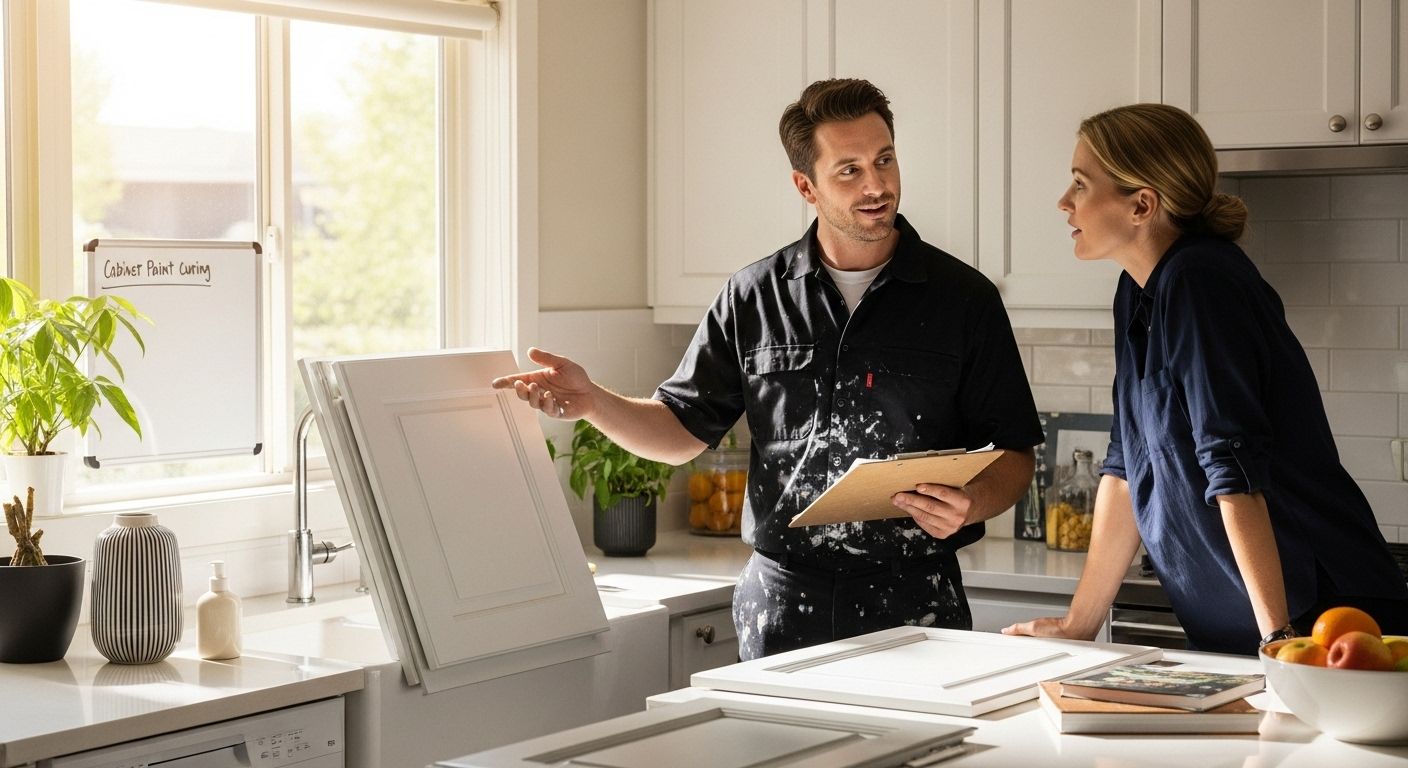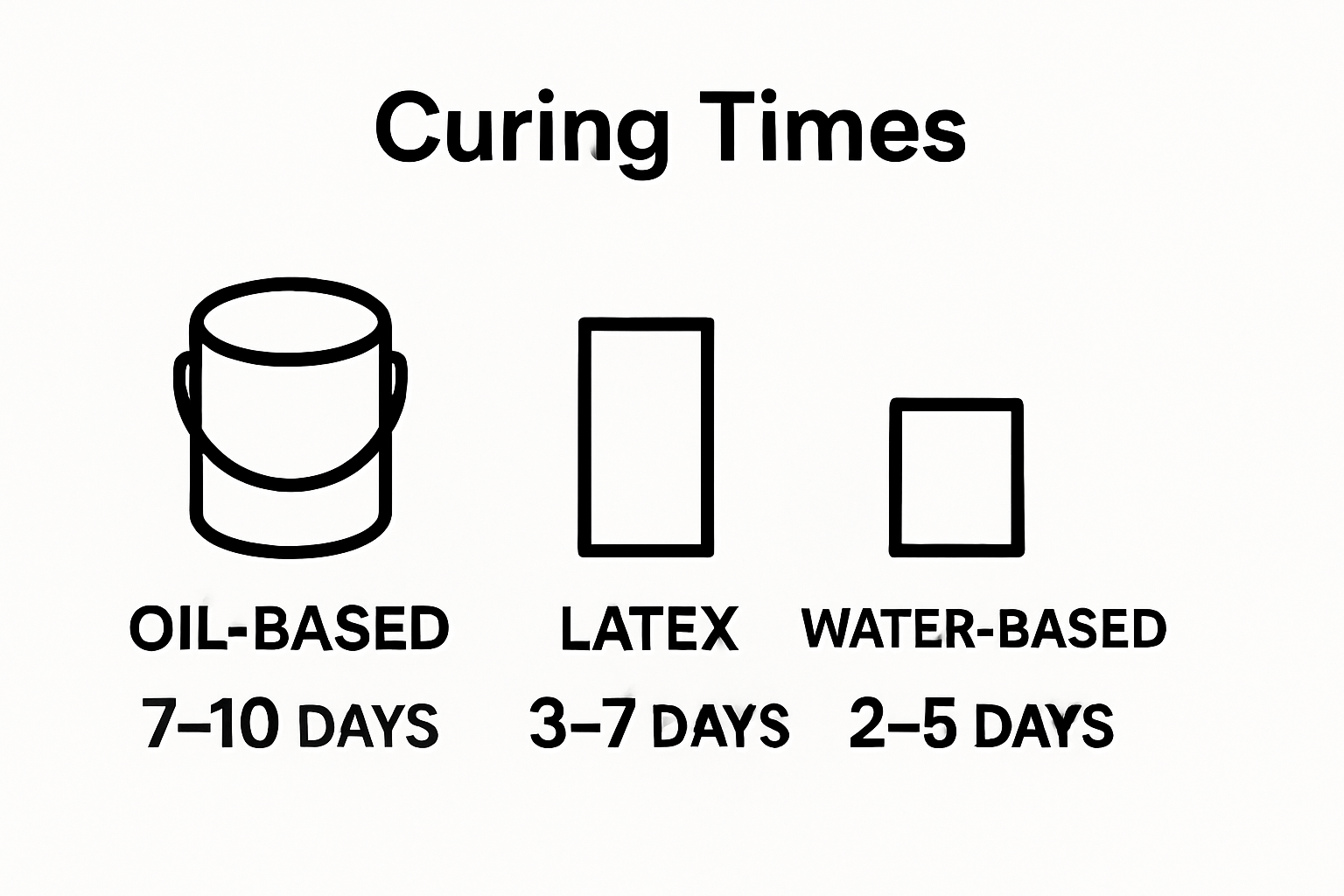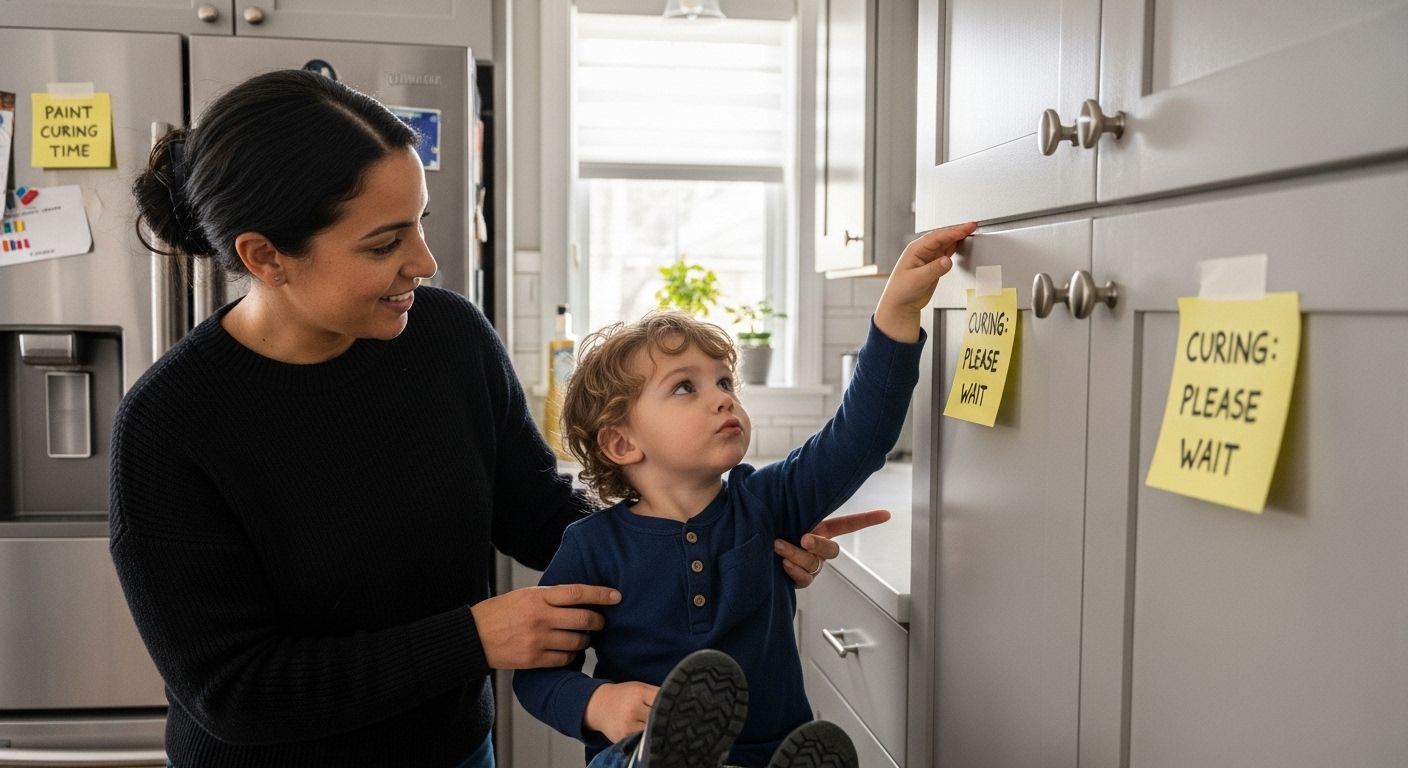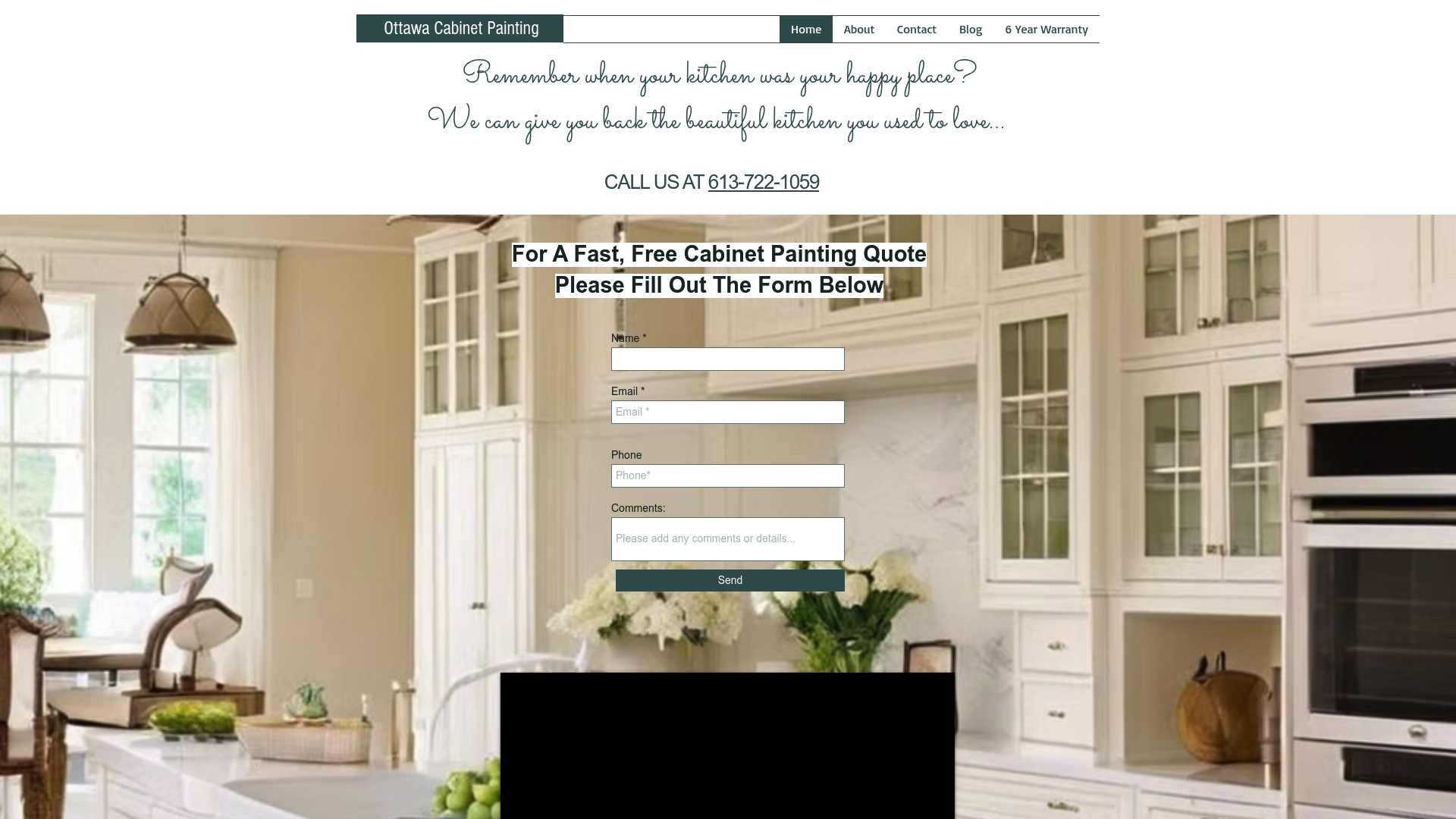Understanding How Long Does Cabinet Paint Take to Cure
- demoore5506
- Aug 28
- 8 min read

Cabinet paint curing does a lot more than make your kitchen look fresh. A fully cured paint surface is up to 10 times more resistant to scratches and peeling than one that’s just dry. Sounds like a win for your cabinets, right? Most people focus on how paint dries, not realizing that the real protection comes from an invisible chemical shift happening after the surface feels dry. That hidden science can make the difference between cabinets that last for years and those that need a redo in months.
Table of Contents
Quick Summary
Takeaway | Explanation |
Proper curing enhances durability | A well-cured paint job prevents premature chipping and peeling, ensuring longevity. |
Temperature and humidity matter | Maintain optimal conditions: 50°F minimum and 40-70% humidity for best results. |
Different paints cure differently | Oil-based paints take 7-10 days, while latex and water-based cure faster, in 3-7 and 2-5 days respectively. |
Avoid contact during curing | Prevent damage to surfaces by not using cabinets until full curing is complete. |
Use high-quality primers and techniques | Effective surface preparation and the right primer are crucial for a successful, long-lasting finish. |
What is Cabinet Paint Curing and Why is it Important?
Cabinet paint curing is a critical chemical process that transforms liquid paint into a hardened, durable protective layer on your cabinets. Unlike simple drying, which only involves surface moisture evaporation, curing represents a complete chemical transformation where paint molecules bond and solidify into a tough, resilient finish.
The Science Behind Paint Curing
Paint curing involves complex molecular interactions where polymer chains in the paint crosslink and form an interlocking network. According to the National Institute of Standards and Technology, these molecular transformations significantly impact the coating-substrate interface, determining critical properties like:
Adhesion strength
Surface durability
Resistance to scratches and peeling
Long-term performance of the painted surface
Why Proper Curing Matters for Cabinets
Improper or rushed curing can lead to multiple problems that compromise your cabinet’s appearance and longevity. A fully cured paint surface provides protection against daily wear, moisture, temperature fluctuations, and potential chemical interactions. Without complete curing, your cabinets remain vulnerable to:
Premature chipping and peeling
Reduced color vibrancy
Increased susceptibility to stains
Weakened protective barrier
For homeowners seeking a professional, long-lasting cabinet finish, understanding and respecting the curing process is essential. Learn more about preparing your cabinets for a perfect paint job to ensure optimal results.
Professional painters recognize that curing is not just about appearance, but about creating a resilient protective layer that maintains your cabinets’ beauty and functionality for years to come. The time invested in proper curing pays dividends in durability, aesthetic appeal, and overall kitchen quality.
Factors Affecting Cabinet Paint Curing Time
Curing cabinet paint is not a uniform process and depends on multiple environmental and product-specific variables. Understanding these factors helps homeowners and professionals manage expectations and achieve optimal results.
Environmental Conditions
According to Purdue University Extension, temperature plays a critical role in paint curing. Most professional-grade cabinet paints require specific environmental conditions to cure correctly:
Minimum ambient temperature of 50°F
Relative humidity between 40-70%
Stable indoor environment without extreme temperature fluctuations
Adequate ventilation without direct drafts
Paint Type and Composition
Different paint formulations have inherently varied curing timelines.

Oil-based, latex, and specialty cabinet paints each demonstrate unique molecular characteristics that influence their curing duration:
To help you compare how different paint types affect curing time and durability for cabinets, the following table summarizes the main characteristics discussed in the article.
Paint Type | Typical Curing Time | Durability After Full Cure | Notes on Application |
Oil-based | 7-10 days | Very high; excellent protection | Longer odor and VOC emission |
Latex | 3-7 days | High; resists chipping and fading | Shorter curing time; easier cleanup |
Water-based Acrylic | 2-5 days | High; good color retention | Fastest cure; lower odor |
Oil-based paints typically require 7-10 days for complete curing
Latex paints generally cure within 3-7 days
Water-based acrylic paints often cure faster, around 2-5 days
Product and Application Specifics
Application techniques and specific product characteristics significantly impact curing time. Thickness of paint layers, primer usage, and surface preparation directly influence how quickly paint molecules bond and solidify. Learn more about protecting your newly painted cabinets to ensure long-lasting results.
Professional painters understand that rushing the curing process can compromise the paint’s durability, adhesion, and overall finish. Patience during these critical days ensures a resilient, attractive cabinet surface that withstands daily use and maintains its aesthetic appeal.
The Science Behind Paint Curing: How It Works
Paint curing represents a sophisticated molecular transformation that goes far beyond simple surface drying. This complex chemical process involves intricate interactions between paint components, creating a durable protective layer through precise molecular mechanisms.
Molecular Film Formation
According to recent research published in Macromolecules, paint curing involves a sophisticated oxygen-driven free-radical polymerization process. When paint is applied, several critical stages occur:
Initial particle concentration through solvent evaporation
Polymer particle coalescence and merging
Interdiffusion of polymer chains
Formation of an interconnected molecular network
Chemical Bonding and Network Development
The curing process creates a complex three-dimensional molecular structure. Polymer chains gradually interlock and crosslink, transforming from liquid to a solid, resilient coating. This transformation depends on multiple factors including temperature, humidity, and specific paint chemistry.
Environmental Influence on Curing
External conditions dramatically impact the molecular curing process. Factors like ambient temperature, relative humidity, and air circulation directly influence how quickly and effectively paint molecules bond. Explore our comprehensive guide on protecting your newly painted surfaces to understand optimal curing environments.
Professional painters recognize that curing is a delicate scientific process requiring patience, precision, and understanding of molecular interactions. The time invested in proper curing ensures a cabinet finish that is not just visually appealing, but structurally robust and long-lasting.
Real-World Implications of Curing Time for Homeowners
Cabinet paint curing is not just a technical process but has significant practical consequences for household functionality, indoor air quality, and long-term surface performance. Understanding these implications helps homeowners make informed decisions and set realistic expectations during renovation projects.
Indoor Air Quality Considerations
According to EPA guidance, the first few days after painting are critical for managing indoor air quality. Paint continues to emit volatile organic compounds (VOCs) during the initial curing phase, which can impact respiratory health and overall home environment:
Maximum VOC emissions occur within first 12-24 hours
Continuous ventilation recommended for 2-3 days post-painting
Children, elderly, and individuals with respiratory conditions are most sensitive
Functional Limitations During Curing
During the curing period, homeowners must exercise caution to prevent damage to the newly painted surface. Premature use can compromise the paint’s integrity and final finish. Practical limitations include:
Avoiding direct contact with painted surfaces
Minimizing humidity and temperature fluctuations
Preventing heavy impacts or abrasive cleaning
Long-Term Performance Expectations
Proper curing directly influences the durability and appearance of cabinet surfaces. Learn more about protecting your newly painted cabinets to ensure optimal results. A well-cured paint job provides:
Enhanced scratch and stain resistance
More uniform color and sheen
Improved adhesion and longevity
Homeowners who understand and respect the curing process will enjoy a superior, long-lasting cabinet finish that maintains its beauty and functionality for years to come.
Best Practices for Optimizing Cabinet Paint Curing
Optimizing cabinet paint curing requires strategic planning and careful environmental management. Professional painters understand that successful curing goes beyond simply applying paint and waiting.
Environmental Control Strategies
According to EPA Indoor Air Quality guidelines, managing your painting environment is crucial for achieving a flawless finish. Temperature and ventilation are critical factors in supporting optimal paint curing:
Maintain consistent room temperature between 60-75°F
Ensure continuous air circulation
Use exhaust fans to remove moisture and volatile compounds
Avoid direct sunlight or extreme temperature variations
Preparation and Application Techniques
Professional preparation significantly impacts the curing process. Discover our comprehensive guide to cabinet preparation to understand how proper groundwork influences final results. Key preparation techniques include:
Thoroughly cleaning and degreasing surfaces
Using high-quality primer compatible with your paint type
Applying thin, even paint coats
Allowing adequate drying time between coats
Post-Painting Care
The weeks following painting are critical for achieving a durable, professional-quality finish. Protect your newly painted cabinets by minimizing stress on the surface:
Avoid hanging items or placing objects on freshly painted surfaces
Keep humidity levels moderate
Delay thorough cleaning for at least two weeks
Handle cabinets gently during the initial curing period
Patience and attention to detail during the curing process ensure a stunning, long-lasting cabinet transformation that will enhance your home’s aesthetic and functionality.
The following table organizes key environmental and care factors that impact cabinet paint curing, along with practical effects on performance and recommended homeowner actions as described in the article.
Factor | Effect on Curing/Performance | Homeowner Action Recommended |
Temperature | Faster cure at warmer temps; slow if too cold | Maintain 60-75°F indoors |
Humidity | High humidity slows curing; too low can cause cracks | Maintain 40-70% humidity |
Ventilation | Reduces VOCs, supports curing | Ensure continuous air circulation |
Contact During Curing | Damages paint, reduces finish quality | Avoid use and touching until cured |
Cleaning/Handling | Weakens uncured paint | No cleaning for two weeks |

Say Goodbye to Cabinet Paint Curing Stress with Ottawa Cabinet Painting
Are you worried about how long your newly painted cabinets need to cure? The risks of premature chipping, dull finishes, and lingering odors can leave every homeowner anxious. You want a kitchen that looks beautiful and stays durable, but the reality of paint curing time can disrupt your daily routine and stretch your patience.
At Ottawa Cabinet Painting, we take the guesswork and frustration out of the equation. Our expert process manages every step, from meticulous preparation to maintaining ideal curing conditions, so your kitchen transformation is smooth and stress-free. With proven techniques and a focus on long-term results, we create a silky, resilient finish that stands up to everyday life. Our team respects your home and timeline, ensuring minimal disruption while maximizing beauty and value. We even back our work with a solid 6-year warranty so you can feel secure in your investment.

Stop settling for unpredictable outcomes or shortcuts. Get the kitchen you deserve and protect your cabinets for years to come. Visit Ottawa Cabinet Painting to request your personalized quote now. If you want to learn more about protecting your cabinets after painting, check out our guide on how to protect painted cabinets. Your kitchen deserves quality, and now is the perfect time to take action.
Frequently Asked Questions
How long does cabinet paint take to cure?
Cabinet paint curing times vary by paint type; oil-based paints typically take 7-10 days, latex paints cure in 3-7 days, and water-based acrylic paints often cure within 2-5 days.
What factors influence the curing time of cabinet paint?
Curing time is affected by several factors including environmental conditions (temperature and humidity), the type of paint used, and the specifics of application such as paint thickness and primer usage.
Why is proper curing important for cabinets?
Proper curing ensures that the paint forms a durable, protective layer that resists chipping, peeling, and staining, thereby extending the life and appearance of your cabinets.
What can happen if I use the cabinets before the paint is fully cured?
Using cabinets before the paint is fully cured can lead to compromised integrity, such as premature chipping and peeling, as well as reduced color vibrancy and overall finish quality.
Recommended

Comments